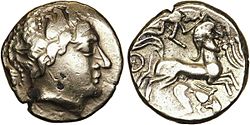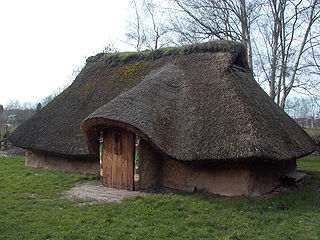
The Andecavi (also Andicavi, Andegavi, or Andigavi) were a Gallic tribe dwelling in Aremorica during the Roman period.

The Andecavi (also Andicavi, Andegavi, or Andigavi) were a Gallic tribe dwelling in Aremorica during the Roman period.
They are mentioned as Andecavi (var.andic-, andeg-, andig-) by Pliny (1st c. AD), [1] Andecavi and Andecavos by Tacitus (early 2nd c. AD), [2] A̓ndíkauoi (Ἀνδίκαυοι; var. Ὀνδικαοῦαι, Ὠνδικαοῦαι) by Ptolemy (2nd c. AD), [3] and as Andicavos (var.andegauus, andecauos, andigabos, andigabus, andicabos) by Orosius (early 5th c. AD). [4] [5]
The etymology of the ethnonym Andecavī remains uncertain. Ande- is a Gaulish intensifying suffix, but the interpretation of the second element is difficult. [6] Andecaui could mean ''those of the big hollow', by deriving the name from the Celtic root *kuwo- ('hollow'; cf. OIr. cúa, 'hollow, cavity'; Welsh keu, 'hollow, closed'; OBr. cau, 'closed, covered'). [7] Pierre-Yves Lambert has also suggested a connection with a shortened form of the Celtic root *kawaro- ('hero, champion'; cf. OIr. cuar 'hero', Middle Welsh cawr 'giant'). [8]
The city of Angers, attested ca. 400 AD as civitas Andecavorum ('civitas of the Andecavi', Andegavis in 861–882, Angieus in 1127), and the region of Anjou, attested in 767 as pago Andegavinse (in Andecavo in 797, Anjau ca. 1071–1127), are named after the Gallic tribe. [9]

The territory of the Andecavi roughly corresponded with the diocese of Angers, Anjou, in the department Maine-et-Loire in present-day France. Although Caesar locates the Andes "near the Ocean", they held no coast and were located inland along the Loire river. [10]
In Book 3 of the Bellum Gallicum, Caesar says that the Andes provided winter quarters for Publius Crassus after his mission into Armorica, which brought several Gallic polities into relations with Rome. [11] Over the winter of 57–56 BC, the Romans built a fleet on the Loire under the command of Decimus Brutus, presumably in preparation for an invasion of Britannia, but which was instead called into action against the Veneti when Armorican objections were raised.
The Andes, led by Dumnacus, played a significant role in the continuing war against Rome after the defeat of Vercingetorix at Alesia. Dumnacus's efforts are recounted by Aulus Hirtius in his continuation of the Bellum Gallicum (Book 8), which covers the two years of the war after Caesar had declared his mission accomplished. Dumnacus lay siege to Limonum (present-day Poitiers), an oppidum of the Pictones, and engaged without success the Roman relief army under the command of Gaius Caninius Rebilus. When additional Roman forces arrived on the scene, Dumnacus was forced to lift the siege and retreat. The army of the Andes was pursued by the Romans and suffered heavy casualties. In a decisive battle the following day, the Romans killed some 12,000 men. Dumnacus escaped, and when Armorica surrendered, he went into self-imposed exile. [12]

The Menapii were a Belgic tribe dwelling near the North Sea, around present-day Cassel, during the Iron Age and the Roman period.

The Lingones were a Gallic tribe of the Iron Age and Roman periods. They dwelled in the region surrounding the present-day city of Langres, between the provinces of Gallia Lugdunensis and Gallia Belgica.

The Bituriges Cubi were a Gallic tribe dwelling in a territory corresponding to the later province of Berry, which is named after them, during the Iron Age and the Roman period. They had a homonym tribe, the Bituriges Vivisci, in the Bordelais region, which could indicate a common origin, although there is no direct evidence of this.

The Bellovaci were a Belgic tribe dwelling in the modern Picardy region, near the present-day city of Beauvais, during the Iron Age and the Roman period. After they were defeated by Caesar in 57 BC, they gave lukewarm support to the Gallic revolt led by Vercingetorix in 52 BC. The Bellovaci nonetheless organized resistance against Rome in 51 BC.

The Carnutes or Carnuti, were a Gallic tribe dwelling in an extensive territory between the Sequana (Seine) and the Liger (Loire) rivers during the Iron Age and the Roman period.

The Venetī were a Gallic tribe dwelling in Armorica, in the northern part of the Brittany Peninsula, during the Iron Age and the Roman period.

The Turoni or Turones were a Gallic tribe of dwelling in the later Touraine region during the Iron Age and the Roman period.

The Aulerci Cenomani were a Gallic tribe dwelling in the modern Sarthe department during the Iron Age and the Roman period. The Cenomani were the most powerful of the Aulerci tribes.

The Petrocorii were a Gallic tribe dwelling in the present-day Périgord region, between the Dordogne and Vézère rivers, during the Iron Age and the Roman period.

The Mediomatrici were according to Caesar a Gaulish tribe at the frontier to the Belgicae dwelling in the present-day regions Lorraine, Upper Moselle during the Iron Age and the Roman period.
The Caletes or Caleti were a Belgic or Gallic tribe dwelling in Pays de Caux, in present-day Normandy, during the Iron Age and the Roman period.

The Lemovīcēs were a Gallic tribe dwelling in the modern Limousin region during the Iron Age and the Roman period.

The Eburovīcēs or Aulercī Eburovīcēs were a Gallic tribe dwelling in the modern Eure department during the Iron Age and the Roman period. They were part of the Aulerci.
The Lexovii, were a Gallic tribe dwelling immediately west of the mouth of the Seine, around present-day Lisieux, during the Iron Age and the Roman period.

The Diablintes or Aulerci Diablites were a Gallic tribe dwelling in the north of the modern Mayenne department during the Iron Age and the Roman period. They were part of the Aulerci.

The Coriosolites or Curiosolitae were a Gallic people dwelling on the northern coast of present-day Brittany during the Iron Age and the Roman period.

The Redones or Riedones were a Gallic tribe dwelling in the eastern part of the Brittany peninsula during the Iron age and subsequent Roman conquest of Gaul. Their capital was at Condate, the site of modern day Rennes.
The Veliocasses or Velocasses were a Belgic or Gallic tribe of the La Tène and Roman periods, dwelling in the south of modern Seine-Maritime and in the north of Eure.

The Sotiates were a Gallic-Aquitani tribe dwelling in the region surrounding the modern town of Sos (Lot-et-Garonne) during the Iron Age and the Roman period.

The Cadurci were a Gallic tribe dwelling in the later region of Quercy during the Iron Age and the Roman period.